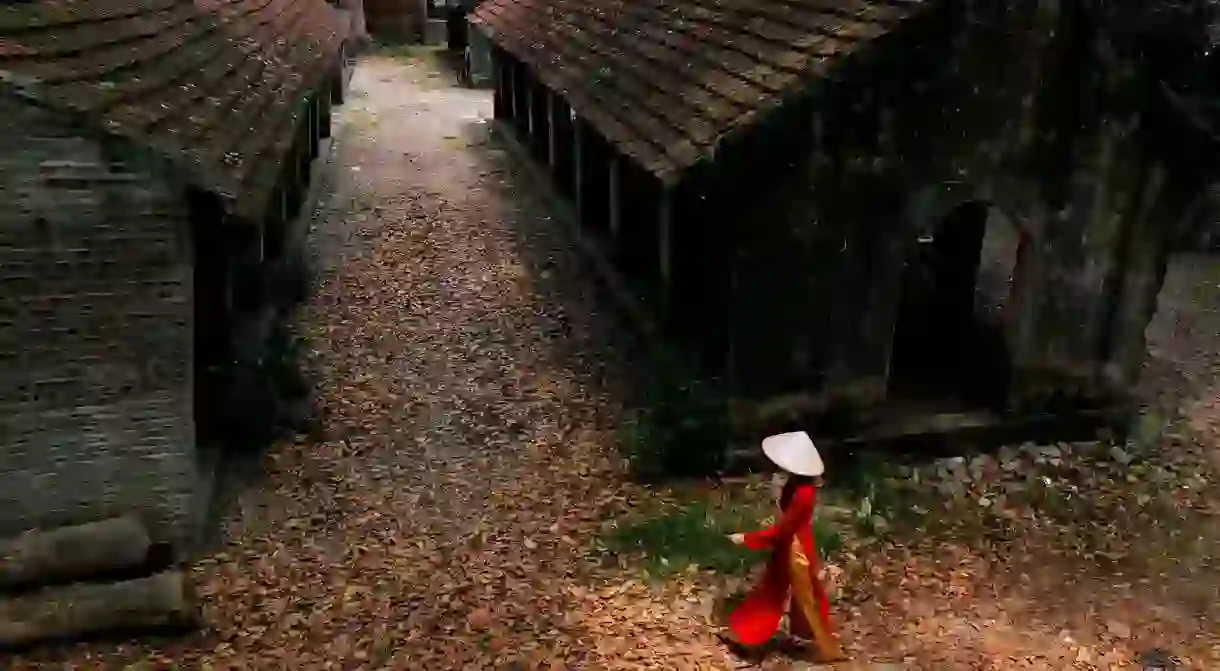The Perfect Walking Guide To Hanoi, Vietnam

Eastern and Western influences converge in Hanoi – Vietnam’s capital and second largest city, which was under French rule until the mid 1950s. Today, Hanoi is the cultural epicenter of Vietnam, a city where old meets new, where local culture captures the imagination, and exploring on foot is paramount.
Hoan Kiem Lake & the Ngoc Son Temple
Our walking tour begins in the morning at one of the main attractions in Hanoi: Hoan Kiem Lake and the Ngoc Son temple (affectionally known as the Temple of the Jade Mountain). Hanoi’s most visited Buddhist temple sits on an island in the center of Hoan Kiem Lake, connected by a fiery red bridge that contrasts sharply with the surrounding nature. The temple is built in a classic Vietnamese style and built to honor the 13th century military leader Tran Hung Dao. Beyond visiting the temple and Hoan Kiem Lake, this area is thought to be a popular place to watch the locals and get a taste of Hanoian life.

Dong Kinh Nghia Thuc Square
The next stop on the walking tour takes you to Dong Kinh Nghia Thuc Square, a busy and popular public square where festivities often take place. The square – known as the Tonkin Free School Movement Square – is named for a movement that helped ignite Communism in Vietnam. From here, you will step into Hanoi’s historic Old Quarter where the rest of the walking tour will reveal shops, charming alleys and delectable eats.
Hang Gai Street & Bún Chả
Hang Gai Street (nicknamed Hemp Street) was once home to an array of hemp outlets. Today, Hang Gai Street is a busy walkway of artisan shops, galleries and silk tailors. On Hang Gai Street, you’ll find a large, old Banyan tree – native to this part of the world. According to Frommer’s, “[the Banyan tree] is like a small temple, with sticks of incense wedged between knobs of the tree and offerings of rice whiskey lining the base.” By this street you’ll also find, Bún chả hàng mành – Đắc Kim, a 4-star restaurant serving the classic Hanoi dish, Bún chả – a perfect meal to start your day.
Yen Thai Street
Yen Thai Street is home to a local, open air market that is hailed as a photographer’s dream. To reach the market, you can walk down the quiet alley of Tam Thuong, which will dead end at Yen Thai Street from where you can take a left to reach the market. Frommer’s recommends visiting the market in the morning for ideal photography lighting.

Bun Bo Nam Bo
Chances are a walking tour of Hanoi’s Old Quarter will have you trying local dishes and street snacks every step of the way. For lunch, make sure to stop at Bun Bo Nam Bo, located at 67 Hang Dieu Street. This local gem is renowned for serving classic, no-frills Vietnamese dishes.
Lan Ong Street
After lunch, head to Lan Ong Street where an array of curious oddities can be found. Lan Ong Street is where Chinese immigrants sell traditional herbs and medicines from tiny storefronts. While this street sadly is the sort of place you will find a monkey paw for sale, it does offer a curious glimpse into traditional Chinese medicine and beliefs, therefore making it worth a visit.
Cha Ca Street
On Cha Ca Street (nicknamed Fish Street) is where you’ll find more recommended restaurants to peruse during your walk. Vietnam Online recommends dining at Cha Ca La Vong Restaurant where you can enjoy classic Hanoian dishes.
Hang Chieu
Follow Hang Chieu and you’ll wind up at Quan Chuong Gate – the only remaining gate from the Thang Long (Dragon Fly) citadel. Continue right and you’ll reach Huong Nghia Communal House off Dao Duy Tu Street. Hanoi’s communal houses were built in the 17th and 18th centuries and are prime examples of a Hanoi from decades past. At Huong Nghia Communal House, visitors can bring offerings and light incense.

Bach Ma Temple
Known as the White Horse Temple, the Bach Ma Temple sits in the heart of Hanoi’s Old Quarter and is said to be the oldest temple in the city. The temple is one of the main tourist attractions for Hanoi visitors where a red lacquered funeral palanquin and white horse statue catch the eye. The temple dates back to the 18th century with the addition of the Confucius shrine added in 1839. According to Lonely Planet, “Bach Ma Temple was originally built by Emperor Ly Thai To in the 11th century to honour a white horse that guided him to this site, where he chose to construct his city walls.”
Tamarind Café
Because one of the main attractions of Hanoi is its food, our walking tour ends at Tamarind Café on Ma May Street. After a day spent roaming Hanoi’s historic Old Quarter, Tamarind Café is a great spot to relax those feet, order a fresh fruit smoothie and reflect on your day in Hanoi.













